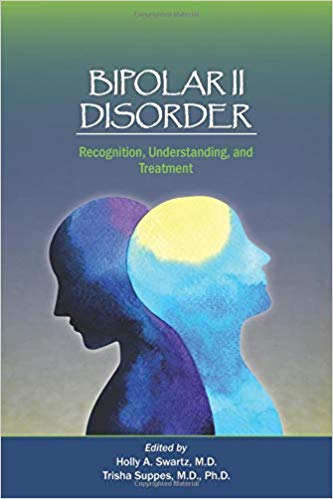Unlike its cousin, bipolar I disorder, which has been extensively studied and depicted in popular literature and on screen, bipolar II disorder is poorly understood, underdiagnosed, and insufficiently treated. Bipolar II Disorder: Recognition, Understanding, and Treatment is the only text on the market that examines every aspect of the disorder in an up-to-date, rigorous, and clinically oriented manner. The editors, experts on the diagnosis and treatment of this neglected illness, have gathered a group of contributors who together advance the reader's knowledge of the disease in a systematic, accessible way, identifying and addressing the challenges of diagnosis and treatment and exploring current thinking on the biological determinants of the disorder. Acknowledging potential pitfalls of differential diagnosis, the book examines psychiatric comorbidities that most typically co-occur with bipolar II, such as anxiety disorders, impulse-control disorders, and borderline personality disorder. Next, the book focuses on the growing body of evidence that suggests that the underlying biology of bipolar II is distinct from that of other mood disorders and discusses the increasingly important role that neuroimaging plays in the diagnosis and understanding of bipolar II disorder as research progresses. Finally, the text explores how to manage bipolar II disorder, providing an up-to-date review of medication options and psychosocial treatments.
The book's strengths are many and compelling: ? Individual chapters are written by experts in the fields of phenomenology, genetics, neuroimaging, psychopharmacology, psychotherapy, child psychiatry, and reproductive mental health who review what is currently known about bipolar II disorder and its management.? A special chapter on suicide describes a framework for understanding risk and a clinical model for conducting suicide risk assessment specific to individuals with bipolar II disorder. The chapter underscores factors associated with increased risk in bipolar II disorder and identifies strategies to mitigate that risk.? Written for a professional audience, the book may also be of interest to patients who want to learn more about their own diagnosis and to those who wish to support them.? Fascinating case vignettes and concise key points are provided throughout the text, helping readers to understand and contextualize the most important information in each chapter for easy reference and review.? Although advances have been made in understanding bipolar II disorder since the diagnosis was first codified in 1994, many gaps remain in the evidence base, particularly related to optimal treatments and neurobiology, and the book examines future directions for inquiry.
For years, clinicians had little guidance for diagnosing and treating bipolar II disorder, relying on treatment options for bipolar I disorder, which were inadequate and of limited efficacy. Bipolar II Disorder: Recognition, Understanding, and Treatment responds to these frustrations with evidence-based, substantive, and up-to-the-minute information, demystifying the disorder and equipping the reader to provide the highest standard of care.
چکیده فارسی
بر خلاف پسرعمویش، اختلال دوقطبی I، که به طور گسترده مورد مطالعه قرار گرفته و در ادبیات عامه پسند و روی صفحه نمایش به تصویر کشیده شده است، اختلال دوقطبی II به خوبی درک نشده، تشخیص داده نشده و به اندازه کافی درمان نشده است. اختلال دوقطبی II: شناخت، درک و درمان تنها متن موجود در بازار است که همه جنبه های این اختلال را به شیوه ای به روز، دقیق و بالینی بررسی می کند. ویراستاران، متخصصان تشخیص و درمان این بیماری نادیده گرفته شده، گروهی از مشارکت کنندگان را گردآوری کرده اند که با هم دانش خوانندگان از این بیماری را به شیوه ای سیستماتیک و در دسترس ارتقا می دهند، چالش های تشخیص و درمان را شناسایی و به آنها رسیدگی می کنند و تفکر فعلی را بررسی می کنند. عوامل بیولوژیکی این اختلال با اذعان به مشکلات بالقوه تشخیص افتراقی، این کتاب به بررسی بیماریهای روانپزشکی میپردازد که معمولاً با دوقطبی II همراه هستند، مانند اختلالات اضطرابی، اختلالات کنترل تکانه، و اختلال شخصیت مرزی. در مرحله بعد، این کتاب بر روی مجموعه رو به رشد شواهدی تمرکز دارد که نشان میدهد زیستشناسی زمینهای دوقطبی II از سایر اختلالات خلقی متمایز است و نقش فزایندهای را که تصویربرداری عصبی در تشخیص و درک اختلال دوقطبی II ایفا میکند، مورد بحث قرار میدهد. در نهایت، این متن نحوه مدیریت اختلال دوقطبی II را بررسی میکند و مروری به روز درباره گزینههای دارویی و درمانهای روانی اجتماعی ارائه میدهد.
نقاط قوت کتاب زیاد و قانع کننده است: ? فصلهای جداگانه توسط متخصصانی در زمینههای پدیدارشناسی، ژنتیک، تصویربرداری عصبی، روانپزشکی، رواندرمانی، روانپزشکی کودک و سلامت روان باروری نوشته شدهاند که آنچه را که در حال حاضر درباره اختلال دوقطبی II و مدیریت آن شناخته شده است، مرور میکنند. یک فصل ویژه در مورد خودکشی چارچوبی برای درک خطر و یک مدل بالینی برای انجام ارزیابی خطر خودکشی ویژه افراد مبتلا به اختلال دوقطبی II را توصیف می کند. این فصل بر عوامل مرتبط با افزایش خطر در اختلال دوقطبی II تاکید می کند و راهبردهایی را برای کاهش این خطر شناسایی می کند. این کتاب که برای مخاطبان حرفهای نوشته شده است، ممکن است برای بیمارانی که میخواهند درباره تشخیص خود بیشتر بدانند و کسانی که میخواهند از آنها حمایت کنند نیز جالب باشد. طرحهای داستانی جذاب و نکات کلیدی مختصر در سراسر متن ارائه شدهاند که به خوانندگان کمک میکند تا مهمترین اطلاعات هر فصل را برای ارجاع و بررسی آسان درک و متنی کنند. اگرچه از زمانی که تشخیص برای اولین بار در سال 1994 تدوین شد، پیشرفتهایی در درک اختلال دوقطبی II انجام شده است، اما شکافهای زیادی در پایه شواهد باقی مانده است، بهویژه مربوط به درمانهای بهینه و نوروبیولوژی، و این کتاب به بررسی مسیرهای آینده برای تحقیق میپردازد.
سالها، پزشکان با تکیه بر گزینههای درمانی اختلال دوقطبی I، که ناکافی و با کارایی محدود بودند، راهنماییهای کمی برای تشخیص و درمان اختلال دوقطبی II داشتند. اختلال دوقطبی II: شناخت، درک و درمان با اطلاعات مبتنی بر شواهد، اساسی و به روز به این ناامیدی ها پاسخ می دهد، این اختلال را ابهام زدایی می کند و خواننده را برای ارائه بالاترین استاندارد مراقبت تجهیز می کند.
ادامه ...
بستن ...










